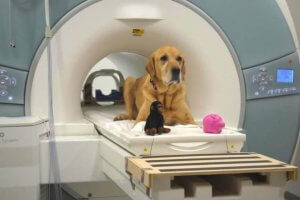How do Dogs Process Words and Commands?

It often seems like dogs understand what we’re saying to them. But how do dogs process words? The experimental results of a new study suggest that dogs have at least a rudimentary neural representation of the meaning of the words they’ve learned.
The study also suggests that dogs differentiate between words they’ve heard before and those they haven’t. This study was published in mid-October 2018 in the journal Frontiers in Neuroscience. Scientists at Emory University (United States) carried out the study. It’s one of the first studies to use brain imaging to test how dogs process words they have learnt by associating them with objects.
How do dogs process words?
Researchers use the example of a dog that gets agitated and excited when he hears the word ‘squirrel’. He even runs to the window. What does this word mean to the dog? Does it mean ‘pay attention, something is happening’? Or does the dog actually picture a squirrel in his mind?
Researchers explain that many dog owners think their dogs know what words mean. However, there really isn’t much scientific evidence to back that up. So, on this occasion, they used their research to get data from the dogs themselves, not just from what their owners say.
We all know that dogs can learn to follow verbal commands. Researchers recognize the fact that dogs have the ability to process at least some aspects of human language. However, previous research also suggests that dogs can use other cues to follow a verbal command. For example, a look, gesture, and even their owner’s emotional expression. So, they wanted to find out to what extent dogs process words and understand them.
The researchers focused on questions surrounding the brain mechanisms that dogs use to differentiate between words. They also looked at what actually constitutes a word for that dog.

We should note that it was necessary to use dogs trained to voluntarily go into a functional magnetic resonance imaging scanner (fMRI). They needed to remain immobile during the scanning process without having to be tied or sedated.
Magnetic resonance study on dogs
For this study, they trained 12 dogs of different breeds to fetch two different objects. They did so based on the names of the objects. One of the objects had a soft texture, like a stuffed animal. The other had a different texture, like rubber, to facilitate differentiation.
During training, the dogs were instructed to fetch one of the objects and then he got either food or praise as a reward. He finished his training when he showed that he could differentiate between the two objects. He showed this by consistently fetching the one his owner asked for when faced with both objects.
During an experiment as part of the same research, the dog would lie down in the fMRI scanner while his owner stood directly in front of him. The owner would say the names of the dog’s toys at set intervals. Then, he would show the dog the corresponding toys. As a type of control, the owner would also pronounce also absurd words. Then he would show the dog new objects, like a hat or a doll.
The results showed a greater activation in the brain’s auditory regions to made-up words compared to with words they were being trained with.
A surprising result
Researchers said that they expected to see dogs differentiate between words they knew and words they didn’t. However, they were surprised to see that the results were the opposite to the results of similar research carried out on humans. What we mean here is that people tend to show greater neuronal activation for familiar words than for new words.

The researchers hypothesize that dogs show greater neuronal activation to new words because they think that their owners want them to understand what they’re saying and they’re trying to do so. “Ultimately, dogs want to please their owners and maybe also get a treat or praise,” the researchers say.
Dogs react to words
Half the dogs in the experiment showed greater activation from the new words in their parietal-temporal-occipital (PTO). Researchers believe this area of the brain may be similar to the angular gyrus in humans. This is where our brains process lexical differences.
However, over half the dogs showed greater activity with new words in other regions of the brain. This includes the other parts of the left temporal cortex and the amygdala, the caudate nucleus and the thalamus.
These differences may be due to the limitations of the study, the variable range in breeds and sizes of the dogs. It could also be due to the possible variations in their cognitive abilities. So, researchers recognize that the variety of the shapes and sizes of the dogs’ brains in different breeds creates a major challenge when mapping canine cognitive processes in the brain.
Dogs with different abilities
In relation to that, the researchers say that dogs process in a different way, according to their abilities and motivations to learn and understand human words. But…”they seem to have a neural representation of the meaning of words that they have learned, even greater than a low-level pavlovian response”.
This doesn’t mean that spoken words are the most effective way for an owner to communicate with his dog. In fact, another study that was conducted by the same team of researchers showed that the neuronal reward system in dogs is more in tune with visual and olfactory signals than with verbal ones.
It often seems like dogs understand what we’re saying to them. But how do dogs process words? The experimental results of a new study suggest that dogs have at least a rudimentary neural representation of the meaning of the words they’ve learned.
The study also suggests that dogs differentiate between words they’ve heard before and those they haven’t. This study was published in mid-October 2018 in the journal Frontiers in Neuroscience. Scientists at Emory University (United States) carried out the study. It’s one of the first studies to use brain imaging to test how dogs process words they have learnt by associating them with objects.
How do dogs process words?
Researchers use the example of a dog that gets agitated and excited when he hears the word ‘squirrel’. He even runs to the window. What does this word mean to the dog? Does it mean ‘pay attention, something is happening’? Or does the dog actually picture a squirrel in his mind?
Researchers explain that many dog owners think their dogs know what words mean. However, there really isn’t much scientific evidence to back that up. So, on this occasion, they used their research to get data from the dogs themselves, not just from what their owners say.
We all know that dogs can learn to follow verbal commands. Researchers recognize the fact that dogs have the ability to process at least some aspects of human language. However, previous research also suggests that dogs can use other cues to follow a verbal command. For example, a look, gesture, and even their owner’s emotional expression. So, they wanted to find out to what extent dogs process words and understand them.
The researchers focused on questions surrounding the brain mechanisms that dogs use to differentiate between words. They also looked at what actually constitutes a word for that dog.

We should note that it was necessary to use dogs trained to voluntarily go into a functional magnetic resonance imaging scanner (fMRI). They needed to remain immobile during the scanning process without having to be tied or sedated.
Magnetic resonance study on dogs
For this study, they trained 12 dogs of different breeds to fetch two different objects. They did so based on the names of the objects. One of the objects had a soft texture, like a stuffed animal. The other had a different texture, like rubber, to facilitate differentiation.
During training, the dogs were instructed to fetch one of the objects and then he got either food or praise as a reward. He finished his training when he showed that he could differentiate between the two objects. He showed this by consistently fetching the one his owner asked for when faced with both objects.
During an experiment as part of the same research, the dog would lie down in the fMRI scanner while his owner stood directly in front of him. The owner would say the names of the dog’s toys at set intervals. Then, he would show the dog the corresponding toys. As a type of control, the owner would also pronounce also absurd words. Then he would show the dog new objects, like a hat or a doll.
The results showed a greater activation in the brain’s auditory regions to made-up words compared to with words they were being trained with.
A surprising result
Researchers said that they expected to see dogs differentiate between words they knew and words they didn’t. However, they were surprised to see that the results were the opposite to the results of similar research carried out on humans. What we mean here is that people tend to show greater neuronal activation for familiar words than for new words.

The researchers hypothesize that dogs show greater neuronal activation to new words because they think that their owners want them to understand what they’re saying and they’re trying to do so. “Ultimately, dogs want to please their owners and maybe also get a treat or praise,” the researchers say.
Dogs react to words
Half the dogs in the experiment showed greater activation from the new words in their parietal-temporal-occipital (PTO). Researchers believe this area of the brain may be similar to the angular gyrus in humans. This is where our brains process lexical differences.
However, over half the dogs showed greater activity with new words in other regions of the brain. This includes the other parts of the left temporal cortex and the amygdala, the caudate nucleus and the thalamus.
These differences may be due to the limitations of the study, the variable range in breeds and sizes of the dogs. It could also be due to the possible variations in their cognitive abilities. So, researchers recognize that the variety of the shapes and sizes of the dogs’ brains in different breeds creates a major challenge when mapping canine cognitive processes in the brain.
Dogs with different abilities
In relation to that, the researchers say that dogs process in a different way, according to their abilities and motivations to learn and understand human words. But…”they seem to have a neural representation of the meaning of words that they have learned, even greater than a low-level pavlovian response”.
This doesn’t mean that spoken words are the most effective way for an owner to communicate with his dog. In fact, another study that was conducted by the same team of researchers showed that the neuronal reward system in dogs is more in tune with visual and olfactory signals than with verbal ones.
All cited sources were thoroughly reviewed by our team to ensure their quality, reliability, currency, and validity. The bibliography of this article was considered reliable and of academic or scientific accuracy.
Prichard, A., Cook, P. F., Spivak, M., Chhibber, R., & Berns, G. S. (2017). Awake fMRI Reveals Mechanisms of Language Comprehension in Dogs. BioRxiv. https://doi.org/10.1101/178186
This text is provided for informational purposes only and does not replace consultation with a professional. If in doubt, consult your specialist.








